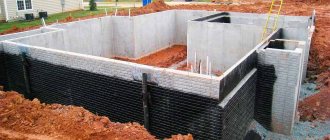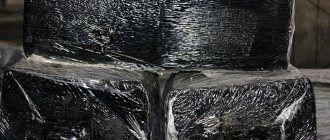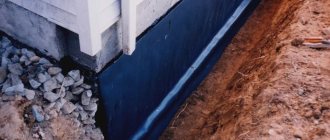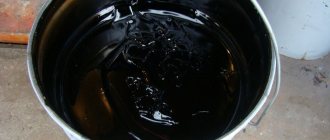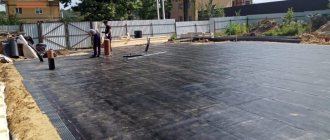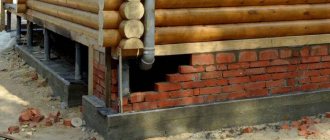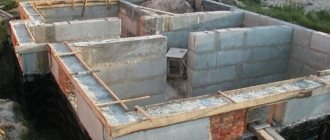0
5005
02.11.2013
One of the inexpensive and uncomplicated ways to protect the foundation from getting wet is waterproofing with liquid glass. Liquid glass is obtained as follows: an aqueous saline solution is mixed with quartz sand and soda, fired and water-soluble crystals of sodium or calcium silicate are obtained, which are dissolved in water to the required thickness.
Foundation waterproofing with liquid glass
The ability of sodium silicate to improve the adhesion of concrete and fill pores with insoluble crystals is the basis of modern mixtures for penetrating waterproofing. It is also possible to use ordinary liquid glass for these purposes.
Foundation waterproofing with liquid glass
This method of waterproofing is characterized by relatively low capital investment and simplicity of application technology. Used for waterproofing walls, floors, swimming pools, basements and attic floors. Distinctive features: protection from chemical influences, dampness, mold and mildew, high fire resistance.
Liquid glass for foundation waterproofing
There are several methods of waterproofing with liquid glass:
- Coating;
- Penetrating;
- When pouring a monolithic foundation.
When using any technology for applying liquid glass, you need to know the following features:
- The material is water-soluble, and its use without additional waterproofing with roll materials is not rational.
- By using sodium silicate in cement and concrete mortar, you reduce its strength. In this regard, the mixture should not contain more than 3% glass.
- The solution hardens in a very short time, which necessitates the preparation of a small amount of the mixture, which can be applied in a minimum time.
Coating waterproofing with liquid glass
The coating method is used in cases where bitumen solutions cannot be used. The layer of liquid glass does not perform a protective function, but when it interacts with concrete, the pores of the concrete surface are filled with compounds that are insoluble in water, which creates waterproofing protection.
Waterproofing the foundation with liquid glass is carried out as follows:
- Preparing the surface for applying a layer of glass. Cleaning the base from construction debris, all kinds of dirt and dust, grease.
- Apply the waterproofing material with a wide brush; after 1 layer has dried, you can begin applying the next one.
- After the entire surface has dried, adhesive waterproofing is carried out.
Penetrating waterproofing based on liquid glass
Indispensable for the accelerated protection of joints and leaks of a prefabricated foundation from water, steam or other liquid. The preparation of the solution is carried out using cement, water and liquid glass; it is carried out in small quantities, since its setting and hardening occurs in an extremely short time.
- The surfaces on which the solution will be applied must be cleaned of dust and dirt, and if necessary, carry out the so-called “unraveling of seams” or tapping of cracks.
- To prepare a waterproofing solution, you need to mix liquid glass with water in a ratio of one to ten - one to fifteen, and then pour the resulting mixture into the dry building mixture and mix once.
- Using a spatula, you need to apply the resulting solution to the cleaned cracks and joints. To increase adhesion, surfaces can be moistened.
Waterproofing when pouring a monolithic foundation
Liquid glass is used together with a concrete mixture to create a monolithic foundation, which provides additional protection from water to the building structure, but at the same time reduces its strength and reliability. This should be taken into account when pouring the foundation. Therefore, you should use enhanced surface reinforcement and thicken the layer of sand bedding.
- All preparatory work should be carried out in advance due to the rapid hardening of the mixture.
- The percentage of liquid glass in the solution should not exceed 5% of the total mass.
- The mixed glass and water must be poured into the cement-sand mixture, mixed and filled with filler.
- After preparing the solution, it must be poured into the formwork, leveled and wait for it to harden.
- The final touch is insulation with polystyrene sheets.
Foundation drainage
To drain water from the outer parts of the foundation and lower the groundwater level in the building area of the house, drainage pipes are used in the gravel backfill. The drainage pipe collects moisture and removes it from the building area, redirecting it further into the drainage well and further onto the terrain - a drainage or storm ditch.
To prevent silting of the drainage filter or mixing of soil with crushed stone, geotextiles should be used to separate the crushed stone backfill from the soil.
A budget substitute for corrugated drainage pipes are ordinary plastic pipes with perforations.
In the case where there is a basement or underground space inside the foundation, it is also protected from groundwater.
The basement floor in this case is a layered “pie”, at the base of which there is a crushed stone cushion, on which a layer of sand is then poured. The sand in this cake is needed to level the surface, on which a footing is then installed - a thin screed that protects the waterproofing.
Types of liquid waterproofing
In modern construction, there are about 10 types of liquid waterproofing. Let's start considering them with an option that has been proven for thousands of years. So, the list opens:
Liquid waterproofing based on bitumen. The latter is a mixture of petroleum or natural resins. They contain 70-80% hydrocarbons, 2-9% sulfur, 1-5% oxygen and up to 2% nitrogen. Proportions may shift, affecting the quality of bitumen
Therefore, it is important to ensure that the resin mixture complies with GOST “6617-76” from 2002
Being organic, bitumen is unstable to temperature changes. At subzero temperatures, the plastic mixture becomes rough and brittle, and can melt in the heat. Therefore, as a liquid waterproofing of foundations, resins are competitive, because they are hidden under the ground or masonry walls.
In such conditions, bitumen is not threatened by direct rays of the sun. The cold can get to you, but fixing the waterproofing on all sides will prevent it from cracking. On roofs, for example, resins fry in the sun. A softened roof can become deformed and sag, especially under the feet of repairmen.
Liquid waterproofing based on glass. In solutions with water it resembles glue. Unlike bitumen, it is 100% mineral and does not contain organic matter. Sodium oxide is mixed with silicon dioxide, or simply silica, in liquid glass. Sometimes, it is replaced by compounds with potassium or lithium oxygen.
As it hardens, liquid glass becomes ordinary, having time to distribute itself throughout the pores of the surface being treated. Mineral waterproofing does not care about temperature changes. Silicate begins to melt at least at 750 degrees.
Therefore, liquid glass for waterproofing is a universal material. Its appeal lies not only in its ability to protect itself from water, but also in its ability to harden surfaces. Soft bitumen only fills them, and the hardened glass makes it stronger and harder than initially.
Liquid rubber for waterproofing. Its composition is polymer-bitumen. Resins are included in the latex emulsion. A film of rubber is formed from it. To make it homogeneous and durable, calcium chloride and other additives are added to the mixture.
The resistance of rubber to temperature changes is higher than that of bitumen. Improved waterproofing easily withstands temperatures down to 60 degrees. You can go up to 170 Celsius in plus.
At the same time, liquid rubber has better adhesion than a conventional mixture of resins. Bitumen is characterized by surface penetration. Latex mixtures go deeper into the base, although they do not break glass records. But liquid rubber stretches well.
This makes it possible to process moving surfaces that change size due to thermal expansion. Liquid rubber is sensitive to solvents. This excludes the use of category waterproofing at chemical plants and gas stations.
Polymer liquid waterproofing. It is a synthesis of liquid glass, cement and rubber. In other words, the material is composite, connecting what can only be found separately in nature. The result is waterproofing that is resistant to temperature changes, penetrating 10-15 centimeters deep into the base. At the same time, the impregnation partially retains elasticity. In this regard, liquid glass, for example, is not malleable and cracks. What if there is an earthquake?
An additional advantage of polymer waterproofing is the ability to treat damp surfaces. Other mixtures are applied only to a dried base. Liquid rubber is placed on slightly damp surfaces. What to do if the basement is flooded and it gets wet through and through? You can't wait for it to dry. This is where polymer waterproofing helps.
Waterproofing can also be divided according to the form of release. Liquids include paints, mastics, plasters, and putties. They, in turn, are divided into superficial and penetrating. For the latter, we will use the term Panetron.
When choosing liquid waterproofing for concrete and other bases, it is important to remember, also, the division of mixtures into:
-Breathable. Such compositions mainly refer to Panetrons. When hardening, the mixtures retain passages in their structure that are sufficient for the penetration of particles of atmospheric gases. There are more water molecules, they cannot leak after
Thus, waterproofing allows you to preserve the ecology of the house, which is especially important in wooden buildings
- Vapor-tight. Mixtures of the category, as a rule, are dislocated on the surface of the material, forming a blank wall.
Waterproofing mixtures are also divided according to the method of application. Some need to be sprayed, others applied with brushes and spatulas. The scope of application of the mixture partly depends on this.
Types of liquid coating
Depending on the method of surface treatment, liquid roofing material can be poured, painted or sprayed.
Loading technology
Self-leveling coating requires the craftsman to operate manually. He needs to treat the base under the liquid roof with two compounds: first with a bitumen emulsion, and then, after it dries, with a primer. As a result, a film with a thickness of 1 to 2 cm should form.
The pouring technology for liquid roofing requires that the master pour the composition from a bucket in portions
The prepared area remains to be gradually filled with liquid waterproofing material, forming a layer of 2 or 3 mm. The layer of self-leveling coating will be smooth if you distribute it over the roof area with a construction roller. It is recommended to apply another layer of liquid material on top of the hardened polymer-bitumen mixture.
Self-leveling technology makes it possible to make the treated surface perfectly flat, but is completely unsuitable for waterproofing pitched roofs.
Video: self-leveling liquid roofing technology
Dyeing technology
Painting the roof with liquid waterproofing material is done manually after treating the surface with a primer. A mixture of rubber and water (30%) is used as the first layer. The composition is spread with a brush or roller and left to dry for an hour if the outdoor thermometer shows a temperature of at least 20°C.
Even tiled roofs are painted with liquid rubber
The second layer of paint coating, 3 mm thick, is formed from liquid waterproofing material, not diluted with water. The composition is spread over the base of the roof perpendicular to the direction in which the first layer of liquid roofing was applied to the surface. The paint coating is leveled with a wide spatula.
Sputtering technology
The installation of liquid roofing using spraying technology involves spraying the composition using an airless pumping apparatus that can drive both an electric and a gasoline engine.
Spraying liquid rubber onto the roof is very quick
The installation is connected to two containers at once. One of them should be filled with bitumen-polymer emulsion, and the other with calcium chloride, which accelerates the hardening process of the liquid coating.
A liquid rubber sprayer has two wires carrying two different liquids that mix at the exit of the nozzleUsing spraying technology, liquid waterproofing is applied on flat or, conversely, significantly inclined roofs. When irrigated, the composition is distributed perfectly evenly on the surface.
Video: spraying liquid roofing
- On the label of liquid rubber you can find information about how many kg of this material are per 1 m2. The roof area is divided by the identified number. This is how the required amount of liquid rubber is obtained. And in order to find out how many containers of the composition will be needed for waterproofing the roof, the total number of kg is divided by the amount that fits into one container of the material. When applying liquid rubber cold and in two layers, one kilogram is usually enough for 3 m2. But these data are only approximate; in any case, it is worth buying 10–15% more waterproofing material than needed.
- The base for installing a liquid roof is cleaned of dust with a damp cloth or a stream of compressed air and inspected thoroughly.
The debris is removed, and any cracks identified are sealed with putty or a mixture of water, sand and cement. Further work is postponed until the hour when the roof surface is completely dry. The roof is checked for defects and only then covered with liquid rubber. - Having chosen the hot method of applying liquid rubber, the composition is heated to 22°, and then immediately cooled so that its temperature drops literally by 7°.
After these manipulations, liquid rubber is promptly poured and distributed over the entire roof. When applying waterproofing material in a cold state, use a wide brush or paint roller, which will help to thoroughly coat the roof and create a neat layer 3 mm thick. On hard-to-reach areas of the roof, use a spatula or a narrow brush. In hard-to-reach areas, it is better to apply liquid rubber with a brush rather than with a roller.
Waterproofing the foundation with liquid rubber
Liquid rubber is an anti-corrosion coating that performs the function of waterproofing building structures and building foundations. It is applied using airless spraying. This material is made on the basis of a bitumen-polymer emulsion. Characterized by cold application and instant hardening.
Liquid rubber application technology
This type of bitumen mastic creates a complete coating, without seams, the material perfectly fills all cracks, seams, and pores of the treated surface, thereby providing ideal protection from water, steam and any other aggressive liquid.
Liquid rubber is not an entirely accurate name; it came into use due to the difficulty of pronouncing the exact term “seamless sprayed waterproofing.” Although mastic is similar to rubber in some characteristics, it is not rubber, and its composition very rarely includes rubber.
Main properties and advantages of the material
Liquid rubber is characterized by the following physical properties, which in turn are the main advantages of this mastic over other waterproofing materials.
- Excellent adhesion to any type of material – high adhesion;
- Durability up to 20 years – maintaining original characteristics throughout the entire service life;
- Flexibility, reliability, strength;
- The material is resistant to high and low temperatures (from -70°C to +90°C);
- Over time, the coating becomes more durable and hard without losing its elasticity;
Properties of liquid rubber
- Fire resistance;
- Resistance to chemical industry products;
- Characterized by ease of repair and restoration;
- UV resistance;
- Cheap repairs;
- Complete absence of seams - absolute solidity;
- No peeling from the base under the influence of adverse natural phenomena;
- Safety and environmental friendliness.
Waterproofing device using liquid rubber
To all of the above, we can add that surface preparation does not need to be done in any special way. Waterproofing the foundation with liquid rubber can also be carried out on a damp base. The use of respiratory protection - respirators and masks - is only required for automated spray application. In this case, the distribution of the waterproofing material occurs automatically, so the mastic is applied smoothly, economically and evenly.
Thickness of sprayed waterproofing
With the automated application method, liquid rubber is applied to the surface in one layer, but if the manual installation method is used, several layers of at least two millimeters are applied. Depending on the distance from the base of the foundation to the earth's surface, the thickness of the spraying changes.
If the foundation depth is from 0 to 10 meters, the thickness of the waterproofing should be at least 2 and no more than 4 millimeters. If the depth is from 10 to 20 meters, the thickness should be from 4 to 6 millimeters. In this case, the consumption of waterproofing material with a minimum thickness is 3 kilograms per square meter.
Famous manufacturing brands
Seamless waterproofing Vodipren and Acrilet are in great demand among builders and construction companies.
The range of Vodipren liquid rubber products consists of:
- made of one-component liquid rubber, characterized by automatic or manual application, suitable for both specialists and private workers;
- made of two-component liquid rubber, for professionals, used together with special equipment;
- colored mastic – used for color coating and finishing of roofs, parking lots, platforms and other surfaces.
Acrilet – colored surface coating. It has a wide range of applications: balconies, roof surfaces, terraces, used as finishing of brick facades, surfaces covered with plaster, for finishing and protecting the internal surfaces of residential buildings and industrial buildings.
General rules for foundation waterproofing
Waterproofing must be carried out in accordance with the rules:
- according to construction technology, it is arranged after the installation of foundation structures, before backfilling the sinuses;
- It is necessary to determine the groundwater level - the choice of insulation type depends on this parameter;
- It is important to take into account the climatic area of construction: the amount of precipitation, the proximity of natural reservoirs determine the method of insulation work;
- if groundwater occurs at a shallow depth, before insulation work begins, it is necessary to drain the water by laying a drainage pipeline;
- the insulated surface must be flat, without cavities;
- concrete leaks, the ends of the reinforcement are cut down, cleaned, irregularities are sealed with mortar or concrete;
- The first stage of installing a waterproofing carpet is a two-layer primer of the base. It is made from primer compositions, applied in an even layer with a material consumption of 400–500 g/m²;
- after the first layer has completely dried, perform the second application;
- To speed up drying, you can use jets of cold or warm air;
- insulating compounds are applied in a continuous, uniform layer;
- when installing the first and subsequent layers of adhesive insulation, it is necessary to maintain a technological break, during which adhesion of the glue to the treated surface is achieved;
- the insulation strips are applied from bottom to top when the protection is directed vertically and from top to bottom when the protection is directed horizontally;
- When working with hot mastics or heated bitumen, fire safety rules must be observed.
Do-it-yourself foundation waterproofing can be done using different methods, but it is important to follow the rules for conducting work.
Making liquid rubber with your own hands
If the work requires a small amount of liquid rubber, then you can prepare the material yourself. To do this, perform the following steps:
Preparation of liquid rubber
- Mix one package of borax with half a glass of water and stir.
- Then the glue and dye are mixed separately.
- Combine the components from two containers and mix thoroughly.
- The finished material is placed in the refrigerator.
When comparing liquid rubber and other waterproofing materials, it should be noted that the first option has many advantages, has a long service life and more reliably protects the foundation from exposure to a damp environment. Consequently, with such protection, the structure can also last for a very long time without deformation or destruction.
No. 5. Where is liquid rubber used?
The material is so unique that it has become widespread in many areas of construction and is sometimes even used for other purposes than its intended purpose. The ability to create an absolutely moisture-proof and seamless coating has made it possible to use liquid rubber in the following areas:
- waterproofing of foundations, ceilings, flat and sloping roofs, basements. The material will protect not only from moisture, but also from mold. Allows indoor and outdoor use;
- waterproofing of swimming pools, fountains and ponds. This is where the increased load on building materials occurs! Liquid rubber allows you to create a waterproofing layer that completely replicates the pool bowl. Moreover, the coating will withstand various types of mechanical stress;
- waterproofing of ventilation outlets, as the material can withstand vibration loads and high temperatures;
- waterproofing surfaces with complex terrain, where it is almost impossible to use rolled materials;
- waterproofing of bridges, tunnels, road sections, and in this area only the most durable and reliable materials are used;
- repair of pitched roofing (tile, slate, metal), installation and repair of roofing made of rolled weld-on materials;
- application in very cold and very hot regions;
- creation of an anti-corrosion layer on metal structures. If liquid rubber creates a coating that is impermeable to water, then corrosion will not be able to develop;
- sometimes the material is applied to wood to protect it from external factors;
- liquid rubber can be used as an independent roofing material.
Surely, in the near future the scope of application of liquid rubber will expand even more, but already now this waterproofing material is considered the most modern due to the cold process and the creation of a seamless, durable coating.
Areas of application
Liquid glass is used in three areas:
- Waterproofing of floors and walls of underground structures: well, swimming pool, basement, etc.
- As an additive when preparing plaster for facades and rooms with high humidity, such as a swimming pool or well. But it should be borne in mind that such a solution hardens very quickly and must be produced immediately. But such walls do not require additional waterproofing.
- Liquid glass can also be used as a modifier additive for concrete, after which it becomes a heavy-duty monolith with water-repellent characteristics. In this case, you must strictly adhere to the proportions (depending on the brand of cement), otherwise you can change the quality of the concrete so much that it itself will become as fragile as glass.
Factors to consider
There is nothing complicated about installing vertical waterproofing for the foundation, but you need to approach the process responsibly. Before starting work, it is necessary to consider a number of parameters:
- ground water level;
- probability of soil heaving;
- precipitation frequency;
- the feasibility of using a particular material;
- level of preparation of the surface and soil for further work.
Correct calculations can be made on the basis of exclusively reliable information. For example, when placing a house in places with high humidity and frequent precipitation, additional use of blind areas and soil drainage may be necessary.
The implementation of high-quality vertical waterproofing involves a long list of works, which is not limited to the selection of suitable material and its application in accordance with the chosen method. Equally important is good pre-treatment of the foundation surface. Preparation is carried out according to the following algorithm:
- Check the base for cracks, cracks and other damage that make the surface uneven.
- Repairing detected defects with special solutions.
- Areas with visible reinforcement or sharp corners are removed, and the “cuts” are thoroughly cleaned.
- After all previous steps have been completed, the foundation is left for 1-2 days to allow it to dry completely.
For some types of insulation, for example, for pasting or coating, the concrete surface of the base is primed in advance.
Penetrating waterproofing is the optimal method of protection
Every builder knows that liquid bitumen waterproofing for concrete can protect a structure from moisture and extend its service life for years. At the same time, concrete can be made waterproof not only by liquid rubber or glass, but also by special water-repellent paint.
This paint can be one- or two-component. Most often this is enamel with high technical characteristics. In some cases, waterproof enamel is used to seal waterproofing seams. This composition is sprayed from a spray bottle, which allows you to control the pressure of the jet and its direction.
If you have to update outdated waterproofing, then the first thing you need to do is remove the cladding and re-plaster the surface. Depending on the object, new reinforcement may be required. Places where cracks have already formed, as well as areas where seams meet, require careful processing.
Regardless of the manufacturer, liquid waterproofing materials for concrete are modern materials with an improved composition. Penetrating compounds of the new generation are in many ways superior to analogues even five years ago.
Liquid waterproofing is known for its high efficiency and ease of installation. It has been noted that even if you apply it with a regular brush and not with professional tools, you can achieve a fairly high quality coating. This means that this material can be used both on large construction sites and in private construction.
Liquid insulators are made from solvents or aqueous emulsions. During the production of the former, substances are introduced into their composition that block the penetration of water at the molecular level. When such liquid insulation hits a surface, its organic solvent evaporates, but its moisture-blocking properties remain. Materials based on water emulsions work according to the same scheme, and the dispersed system quickly hardens and does not emit an odor. This explains the popularity of this type of liquid insulation.
No. 7. Roof waterproofing with liquid rubber
For arranging roof waterproofing, the spraying method is best suited - the equipment is mobile enough to easily cover all roof elements with the material, even the most inaccessible and convex ones. It is better to work in dry weather at air temperatures above +5C. It is better to apply to a dry surface, but installation on a damp surface is not prohibited.
It’s unlikely that anyone will buy or rent equipment to do all the work themselves, but it’s still worth knowing how it works. This will help you know exactly what the experts are doing on your roof and, if anything happens, ask them important questions.
The procedure is as follows:
- cleaning the surface from dust and debris. The efficiency of this stage is increased by using a hydro-jet unit, which supplies water under high pressure. The jet allows you to cope with quite complex contaminants. After this, the surface is dried and grease stains, if any, are removed. This is best done using the burning method;
- priming. Some specialists skip this stage, but with it the coating is more durable and resistant. The first layer of waterproofing is applied to the prepared base;
- The spraying of liquid rubber itself is carried out in strips 1-1.5 m wide, the distance between the surface and the working tool is about 40 cm;
- for roofing, 2-3 layers of liquid rubber are usually used, sometimes fiberglass or geotextile is used between them;
- polymerization processes at a temperature of 20-25C are completely completed after three days.
If it is not possible to hire specialists, then you can try to do everything manually. However, we advise you to stock up on time and patience in advance. Waterproofing is applied after preparatory work. The surface must be clean and nothing should fall off. In which case you will have to use a cement-sand mixture. The solution is applied with a thickness of 3-4 mm. When the first layer has set, you can proceed to applying the next one. After complete polymerization, you can begin installing the roofing material.
Do not be alarmed if during drying you find droplets appearing on the surface. This is a normal process, which is explained by the presence of a catalyst. When applying a layer of waterproofing 2 mm thick, the consumption of liquid rubber will be 3 liters per 1 m2, with 3 liters - 4.5 l/m2, and with 4 mm - about 6 l/m2.
Methods for waterproofing the foundation of a house from the outside
In order to prevent destruction, waterproofing the foundation of a house from the outside can be done in the following ways:
- surface treatment with penetrating compounds;
- coating the outside of the foundation with bitumen mastics;
- covering the external walls of the foundation with rolled types of waterproofing: roofing felt, glass insulation, rubemast and other materials.
There are cases when it is necessary to use two types of waterproofing simultaneously in order to increase the level of protection against the effects of groundwater and precipitation. It all depends on the type of soil, the features of the site on which the house is being built and other factors that experts take into account before carrying out work.
Penetrating waterproofing
Penetrating waterproofing is a fairly new material that has quickly gained the trust of specialists in the construction industry. The market offers a large selection of penetrating compounds with excellent ductility, high adhesion and excellent hydrophobic properties.
Waterproofing the foundation from the outside begins with cleaning the surfaces from dirt, dust, mortar residues, etc. After this, the outer walls of the foundation are thoroughly moistened with water, the cracks are opened and also well moistened.
The penetrating composition is applied with a wide brush in two layers, with a time interval of 2-4 hours between them, carefully sealing the seams and cracks. Having carried out such waterproofing of the foundation, you can be sure that all the pores of the concrete will be closed, without giving the slightest chance for capillary penetration of moisture.
Roll waterproofing
Waterproofing the foundation using rolled materials is the most common method, as it is the most cost-effective and fairly reliable. Pasting with roofing felt or a more modern product based on fiberglass allows you to achieve effective protection of the structure from moisture.
Foundation waterproofing is done as follows:
- the surface is cleaned and primed with bitumen primer;
- installation of roll insulation - melting the bottom edge of the material and gluing it to the foundation walls, gradually unrolling the roll.
Such waterproofing of the outer surfaces of the foundation must be carried out with an overlap of sheets of at least 100 mm. Particular attention should be paid to the outer corners when transitioning from a vertical to a horizontal surface, reinforcing the area with an additional strip of material of 300 mm. If the depth of the structure exceeds 3 meters, then the foundation is waterproofed with rolled materials in several layers to achieve perfect sealing. When backfilling the foundation, it is necessary to make a drainage layer close to the walls: sand and gravel, and build a clay castle on top with a slope from the surface of the foundation.
Coating waterproofing
How to waterproof the foundation from the outside if the budget is limited and you have to do the work yourself? In this case, the ideal option would be a coating method of protection using bitumen mastic. Waterproofing the foundation is carried out as follows:
- the walls are thoroughly cleaned of dust and dirt, sharp protrusions are removed, porous areas are filled with cement mortar;
- bitumen primer is applied to a dry surface in one thick layer, avoiding gaps;
- after the primer has dried, bitumen mastic is applied using a roller or brush, keeping the stripes parallel and moving according to the up/down principle;
- the second layer is applied after the previous one has completely dried, repeating the process until the coating thickness is at least 3-4 mm.
When waterproofing the foundation, in order to save money, it is not recommended to use pure bitumen, since without special additives, such a coating will quickly begin to crack. Bituminous mastics, with plasticizers, increase the strength, elasticity and durability of the material, allowing for effective waterproofing of the foundation from the outside.
Features of material application
Applying liquid rubber using a sprayer There are several methods for sealing the base using liquid rubber. The choice of one of them is determined by the experience of the masters and their capabilities.
Liquid rubber is applied using one of the following options:
- Using a special sprayer with a gasoline or electric drive. It is an equipment to which 2 containers are attached. One of them contains liquid rubber, the other contains a hardener. Thanks to the sprayer, liquid rubber can be applied to both horizontal surfaces and vertical areas. This allows you to create solidity and reliable protection of the foundation.
- By pouring and evenly spreading.
- Using available materials: brush, spatula, brush.
Despite the large selection of application methods, the most optimal is the first one, that is, using a special sprayer. The latter can be either domestic or imported. To carry out the application procedure, 2 people are enough. In one working day you can cover up to 2000 m².
Drying time ranges from 4 to 24 hours on average. The final time is determined by external conditions: in dry sunny weather the material will dry faster.
Well-known manufacturers and prices
Each manufacturer has its own proprietary secrets for the production of liquid rubber, which remain unpublicized.
Today, many countries are engaged in the production of the material:
- Israel;
- Italy;
- Canada;
- Russia.
The cost of tires varies greatly and depends on many factors.
For example, liquid rubber from the famous brand Plasti Dip will cost 4,500 rubles for 3.8 liters. When purchasing material from a domestic one, which needs to be used for manual application, it is enough to pay 150 rubles per 1 kg.
Below are the prices for 1 kg of liquid rubber from the most popular companies:
| Brand | Price |
| Mastic 33 | From 100 |
| Profix | From 110 |
| Slav | From 80 |
| Ultramast | From 90 |
| Daclar | From 120 |
Spraying with liquid rubber - technology
Spraying technology involves the formation of a waterproofing coating by spraying material onto the surface of even the most complex configuration. This type of work is characterized by fast turnaround times and long-term operation, regardless of possible loads.
Carrying out work on applying liquid rubber to a surface requires strict adherence to several stages, the quality of each of which will determine the final result:
Carrying out preparatory work
As part of the first stage, surface preparation is carried out. The base for subsequent application of liquid rubber must be dry and clean; all contaminants and even dust must be thoroughly and effectively removed from it; in some cases, it is better to use a special hydro-jet installation for this. Be sure to remove traces of oil and fat. It is necessary to completely or partially remove the old roll waterproofing if it has delaminations. Work can only begin if the ambient temperature is above zero.
Priming
The priming stage involves applying the first primer layer of a rubber base, which ensures ideal adhesion of the material to the surface. The base has excellent penetrating properties, which makes it possible to eliminate the appearance of voids and cracks in the future.
The primer is sprayed using special equipment. Additionally, the supply of hardener is blocked, due to which the process of converting the mass into polymer occurs more slowly and the composition penetrates deeper into the surface. Priming must be carried out very carefully, avoiding omissions, and always taking into account the type of surface on which it is applied.
Application of the main waterproofing layer
To ensure high-quality application of the main layer of liquid rubber, a number of nuances and spraying rules should be taken into account:
- the distance from the sprayer to the surface to be treated should not be less than forty centimeters;
- Spraying must be carried out at an angle of 90 degrees evenly, avoiding the appearance of sagging;
- the consumption of the mixture to create a coating 2 millimeters thick is about 3 liters per 1 square meter.
Application of the base layer is the final stage and does not require additional protective coatings. Under the influence of the environment and catalysts, a gradual process of polymerization (solidification) occurs, in which third-party intervention is not required.
Methods of vertical moisture insulation
Waterproofing of the foundation of the house is required to be carried out in accordance with SP 28.13330.2012. For these purposes the following materials are used:
- paint and varnish and impregnating compositions;
- mastics;
- waterproof plaster mixtures;
- self-adhesive or weld-on products in rolls.
Protected base
Based on the installation technology of the protective coating being created, waterproofing is divided into the following types:
- welded;
- coating;
- plastering;
- injection;
- impregnation;
- sprayed.
Use of coating materials
Do-it-yourself foundation waterproofing with coating materials is carried out using bitumen-polymer or bitumen mastics. When applied, a waterproof layer is formed on the surface.
When there is hydrostatic pressure, then coating materials are used as follows:
- bitumen mastics are used if the pressure does not exceed 2 meters;
- when it is from 2 to 5 m, then they work with bitumen-polymer compositions.
Applying mastic
Mastics are applied to the work surface in several layers: from 2 to 4. This is determined by the depth of the foundation:
- if it is up to 3 m, then a layer 2 mm thick is formed;
- when the depth is up to 5 m, then the height of the protective coating is chosen from 2 to 4 mm.
The advantages of the material are as follows:
- relatively low price;
- no special skills are required to apply mastics;
- high degree of elasticity and adhesion.
But the service life of the created bitumen coating is about 6 years. Then it becomes covered with cracks. To increase the period, polymer substances are added to the composition of the product.
The coating technology consists of the following manipulations:
- prepare the working surface of the foundation, clearing it of dirt;
- reinforce joints using fiberglass tapes;
- processed using a roller (brush), primer (primer);
- wait for it to dry completely;
- then apply the required number of layers of mastic.
Pasting with roll products
This method involves both the use of only rolled products and their use in conjunction with mastics. The traditional working material in this area is ordinary roofing felt. It has been replaced by modern roll products with improved performance characteristics. An example of this is products from. The service life of the created waterproofing when used is up to 50 years.
The average thickness of the protective coating layer is 5 mm. It is determined by the type of waterproofing material used. The material can be applied in 2-3 layers.
Work with roll materials as follows:
- clean the surface of the foundation from dust and dirt;
- treated with a primer;
- cut fragments of the required length from the roll;
- apply adhesive mastic;
- fix the pieces on the surface of the base.
Fusing of rolled insulation
If fragments of material are fixed by heating them with a torch, then the method of fixation by fusing is obtained.
Plastering with waterproof mixtures
Another way to protect against water is to use waterproof plaster mixtures. Compositions such as hydroconcrete and polymer concrete are used.
The technology of work is similar to plastering walls using beacons. In this case, the thickness of the applied layer should be at least 2 cm.
The advantages of the option are:
- comparative cheapness of working material;
- no need to create a perfectly flat surface;
- ease of work.
Plastering the foundation
The disadvantages of this method are the following:
- the level of resistance to moisture is inferior to rolled and coating materials;
- Waterproofing made in this way has a short service life: after about 5 years it begins to crack.
Injection method, sprayed and impregnating materials
The injection method is based on pumping polymer mixtures under pressure. Compositions are produced based on polyurethane, acrylic, or mineral. They are close in density to ordinary water.
Polyurethane compounds require at least 1.5 liters per square meter, and acrylic compounds require less.
During operation, holes with a diameter of 25-32 mm are drilled with a hammer drill, which is determined by the size of the inserted capsules and packers. After injection, they are sealed with ordinary cement-sand mortar.
Sprayed waterproofing
Spraying of the insulator is carried out with a special sprayer. The method is convenient to use if the protected structure has a complex structure. But the cost of the material is high, which limits the spread of the method.
Concrete is also isolated from water by impregnating it with special organic-based binders. The applied material fills microcracks in the base, penetrating 3-4 cm deep into it.


